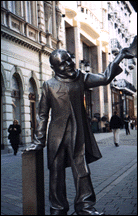 FACTS FOR TRAVELLERS FACTS FOR TRAVELLERS |

May, June and September are the prime visiting months for Slovakia, although April and October are chillier and sometimes cheaper alternatives. Most Slovaks take their holidays in July and August when hotels and tourist sights are usually crowded. Centers like Bratislava and mountain resorts can cater for visitors all year round. Elsewhere, from October or November until March or April, most castles, museums and other tourist attractions, and some associated accommodation and transport, close down.
 Currency Currency |
The Slovak unit of currency is the Slovenska Koruna (SKK, Sk), or Slovak crown. Each crown is divided into 100 haliers. Coins come in denominations of 10, 20 and 50 haliers, and 1, 2, 5 and 10 SKK. Bills come in denominations of 20, 50, 100, 500, 1000 and 5000 SKK. One USD is approximately 48 - 50 SKK, one Euro is approximately 45 SKK, one GBP is approximately 70 SKK and one DM is approximately 23 SKK. For the current rate of exchange check any major newspaper.
 Banks and Money Exchange Banks and Money Exchange |
Only exchange money in banks and certified exchange offices. Exchanges offices can be found in all major hotels, travel agencies and department stores. They are denoted as ZMENAREN (Exchange / Cambio / Wechsel). Most freely convertible currencies can be exchanged into Slovak crowns (SKK) at these exchange bureaus.
 Credit Cards and Checks Credit Cards and Checks |
Eurocard, MasterCard and VISA are accepted at most financial institutions. Banks also accept Diners, American Express, and Eurocheques although with less regularity. International hotels also accept most credit cards. It is recommended to use preferably the VISA and MasterCard in Slovakia. Credit cards are starting to be widely used and are accepted at most hotels, gas stations, more exclusive restaurants and shops.
Travelers' cheques are generally not accepted in stores, small hotels or restaurants, although Eurocheques are taken at some locations. Banks and exchange offices will exchange travelers' cheques for a fee. A convenient way of accessing cash outside business hours is to use an automated teller machine (ATM), usually marked as BANKOMAT (bank machine). Most Slovak ATMs belong to one of the major international banking systems such as MasterCard, VISA, Plus, Maestro or Cirrus.
 Time zone Time zone |
Slovakia uses Central European Time (CET) along with other countries like Germany, Poland and Italy. Officially it is GMT + 1 hour (London), EST + 6 hour (New York) PST + 9 hour (Los Angeles).
Shopping hours:
Most establishments are open between 9 a.m. to 6
or 8 p.m., but some take lunch breaks. Banks usually
close at 5 or 6 p.m. On Saturdays, most stores close
by noon, and few are open on Sundays. Nevertheless,
there are some 24-hour convenience shops usually
located at gas stations. |
 Driving Driving |
An International Driving License is valid in Slovakia. All the while road signs and rules comply with European standards. On freeways and highways drivers must have annual toll labels that can be purchased at border crossings, post offices, and gas stations.
Speed limits are 60km/h in cities and towns, 90km/h on open roads and 130km/h on multilane freeways (unless otherwise marked). Seat belts are compulsory for all passengers. Children under 12 and animals are not allowed in the front passenger seat. Be aware that all vehicles must have a first aid box, towrope, hazard triangle and a spare tire. If you are caught violating any of these laws a fine is payable on the spot or your vehicle will be impounded.
The blood-alcohol level in Slovakia is 0.0. Basically, if you drink any alcohol you can't drive.
Gas (BENZIN) is sold in several unleaded varieties (Natural 95 & 98) with a special mixture (UNI91) for older cars. Diesel fuel is also available. Many multinational companies (OMV, Shell, ESSO) have their gas stations in Slovakia. The domestic producer of gas is Slovnaft, which is the most common in Slovakia.
Road conditions are generally up to Western standards. A new transnational highway is being built between Bratislava and Presov.
Smoking:
As everywhere in the world, the trend in Slovakia is to stop smoking, in spite of which a good proportion of population still smokes. Smoking is forbidden in public transportation, cinemas, and theatres. Many restaurants have common areas for smokers and non-smokers, although they should have segregated sectors.
 Telecommunications Telecommunications |
Slovakia is slowly upgrading its telecommunication system. Data communication services (e-mail, Internet) are quickly expanding throughout the country as another forms of communication.
Country telephone code:
+ 421 (Bratislava: + 421 2)
 Local telephone calls Local telephone calls |
Public phones charge SKK 2 a unit (about 8 seconds of local talk time), but most public phones require telephone cards, which can be purchased at post offices, railway stations, department stores, kiosks and hotels. Card phones are available in 50 or 100 unit denominations.
International telephone calls:
To call from Bratislava directly to other countries, use the international access code 00, than your country code (US - 1, Germany - 49 etc.), the city code, and then the local number.
 Video system Video system |
PAL/SECAM (incompatible with NTSC system in North America)
Voltage & Adapters:
220 volts / 50 Hz, Slovakia uses the standard continental European "Euro plug", with 2 round pins, socket and plug system also found in Germany, France, etc.
 Some Slovak expressions Some Slovak expressions |
Map expressions:
| nabrezie (nabr.) | Embankment | namestie (nam.) | Square | | ulica | street | cesta | road |
| Good day | Dobry den | Good morning | Dobre rano | | Thank you | Dakujem | Please | Prosim |
|

